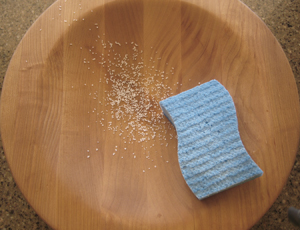One of my favorite cutting boards is the
John Boos Round Herb Cutting Board that came with a nifty mezzaluna rocker knife. Not only is this board superb for chopping herbs, I use it every day to hold an unruly fruit or vegetable. The concave bowl just seems perfect for hugging that last lemon, a spare onion, or a shiny apple just waiting to be eaten. Unfortunately, I did not notice my onion went bad one day and it left a really nasty stain on the board. I wiped it up, but it had penetrated pretty deeply. Then I procrastinated about 6 months before doing anything about it! Maybe this sounds familiar. But don't fret; there is hope.
Unsightly stains and deep scratches can be removed from butcher block to help restore their appearance. Stains can result when liquid spills are allowed to dry on the block. If addressed soon after, they can be removed pretty easily by wiping with a damp, soapy sponge, drying with paper towel, then applying some Boos Bees Wax Board Cream.
Penetrating stains, older stains, and knife gouges in butcher block will require some "muscle" but they usually can be removed!
How to remove Stubborn Stains and Scratches:
1 - The first step is to try and remove the stain by sprinkling kosher/table salt on the stained area and rubbing with a damp sponge for a few minutes. Always rub in the direction of the wood grain to avoid further scratch damage. If the stain is still present, continue to step 2; otherwise, wipe clean and move on to step 5 to finish up.
2 - Stubborn stains or deep scratches will require sanding. There is no set "grit" or coarseness of sandpaper to use.
You will want to experiment, starting with a finer grit and working to a coarser one, until you find the grit that works. I can't say this enough - always rub in the direction of the wood grain (not against it). Trust me, you will be tempted to do so, but please don't, or risk further scratching the board. Once you see the stain or scratch is being removed, stick with that sandpaper. Remember: the higher the number, the finer the grit. Given butcher block is a very hard wood, it makes sense that you will need to use a coarse grit in the range of 80 to 100to correct the problem.
3 - I would start with 150 grit and if that does not work, move to the 100 grit or 80 grit.
4 - When the stain is removed, be sure to use a couple different grit papers to sand the area to a smooth finish again. Use the 150 grit first, then finish with a 220 grit paper to restore the smoothness.
5 - Wipe the butcher block with a damp, soapy wash cloth to remove sanding dust and dry thoroughly.
6 - You must treat the exposed surfaces with a food safe mineral oil to protect and moisturize the wood. The best cure is to apply
Boos Mystery Oil to penetrate the cutting board and restore the moisture. Then follow with an application of
Boos Block Board Cream to put a protective seal on the block and reduce the chances of future spills penetrating the wood.
7 - Remember, you should apply oil or cream to your butcher block once a month to keep your board healthy.
Given my Round Herb Board is Hard Rock Maple it took me a while to find the right grit to remove the stain. I was surprised that I had to go down to a 60 grit and sand for about 15 minutes. But it was worth it! Then I used the 100, 150 and finally 220 grit, respectively, which left it feeling silky smooth again.
My beloved Herb Board looks like new. Herb is happy too!
